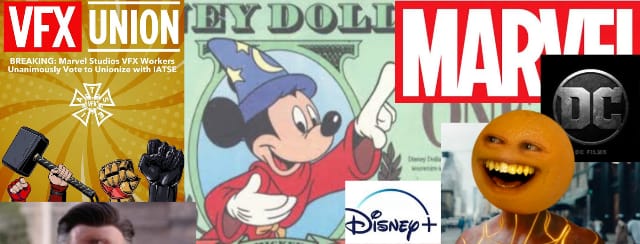Good morning, good day and salutations my deliciously vile minions. I do trust you’re all out there hustling and grinding the world to its knees. It’s been very very bad.
Speaking of bad, have any of you wondered why the VFX in the modern swath of superhero and CGI-heavy films is so remarkably shitty? Of course you have, it’s one of the defining features of the genre at this point. And I wouldn’t think it such an issue if I were watching a superhero movie made fifty years ago, limited as technology was at the time but we know these production houses can do better, I mean think of the visual effects in the first two Iron Man films. So why don’t they do better if they have the capability? Surely with the amount of skill, talent and technology at Hollywood’s disposal, it can produce artistic works of the highest quality? Works that have incredible visual effects and jawdropping cinematography, that feel like a glorious, beautiful punch to the eyeballs (in a good way).
Turns out, Hollywood can’t, or more accurately, won’t. Not reliably. And that’s because of the gloriously diabolical thing known as late-stage capitalism. In this case, companies pushing their VFX artists to fulfil insane workloads under insane deadlines. Don’t misunderstand, some incredible visual effects are being produced these days, but they take time, lots of it. (Think James Cameron’s Avatar movies – I am not a huge fan of the storylines mind you, but the films look incredible) or lots of creativity (think Everything Everywhere All At Once, and they didn’t have anywhere near the budget Disney or Cameron have). The big studios don’t really provide the space for time nor creativity, hence the overall quality of shows have suffered, as have the working conditions of the VFX artists.
A few years ago I genuinely believed we were living in the Golden Age of Entertainment, and there’s certainly a lot of media being produced, but I’d argue that what we’re being presented with as mainstream fodder is of a distinctly meh quality as most things that are mass-produced tend to be. Just think of The Flash (2023) movie and Doctor Strange’s derpy third eye in Doctor Strange in the Multiverse of Madness (the movie had a ton of genuinely beautiful visual effects, don’t get me wrong, but that eye made me cackle). We received nine Marvel products in 2022: five movies and four TV series and we’ll probably be receiving nine products again this year with four films and five TV series. Which is a rather far cry from the one or two films a year from previous Phases.
So, we are positively drowning in content, no? And the VFX artists are positively drowning in lucrative work, are they not? Is this not a good thing?
Well, not really. Working conditions for VFX artists have been abysmal. Many of them reportedly work ten-hour-plus days, with nary a day off in between to meet the fairly insane deadlines set by studios, for pay that does not sustain VFX artists or VFX studios, who are all in a race to offer the cheapest labour to remain competitive with other studios. Granted, it’s not the lowest-paid job out there in this day and age of precarious employment and working conditions, but it’s still an industry facing exploitation and unfair working conditions.
A moment that comes up constantly in most articles you’ll read about the conditions of VFX Studios is one that happened at the 2013 Oscars, when Bill Westenhofer, the VFX supervisor of Life of Pi was cut off in the middle of making his acceptance speech because he mentioned that their studio, Rhythm & Hues, actually went bankrupt during the making of the film. A contributing factor to this was the fact that partway through the production process, Ang Lee, the director of the film wanted huge changes made, and the studio didn’t have a large enough profit margin to begin with, so this ended up costing them a great deal of money and sending them under.
Luckily, as of 2023, while SAG-AFTRA and WAG were striking, Marvel’s in-house VFX Studio unanimously voted to unionize with the International Alliance of Theatrical Stage Employees (IATSE), shortly followed by the Disney VFX artists. While these studio-affiliated artists only represent a small portion of VFX artists, it is still an important step for the industry as a whole and a hopeful step for artists to push for better pay and a better quality of life. If we as consumers know the people who worked on our favourite shows are receiving a living wage and enough time off to, you know, be a human person once in a while, then we can enjoy said shows even more. Wouldn’t that be nice?
Sources:
– Codega, L. (2022, August 12). Abuse of VFX artists is ruining the movies. Gizmodo. https://gizmodo.com/disney-marvel-movies-vfx-industry-nightmare-1849385834
-Gallagher, S. (2023, June 15). Why the Flash CGI is so bad – Is the VFX unfinished?! ScreenRant. https://screenrant.com/the-flash-movie-cgi-problems-unfinished-vfx/
-Hood, C., & Gallagher, S. (2023, November 15). All Marvel movies releasing in 2023. ScreenRant. . https://screenrant.com/upcoming-marvel-movies-2023-release-dates/
-Parkin, S. (2023, January 31). How Hollywood is breaking the VFX industry. British GQ . https://www.gq-magazine.co.uk/culture/article/hollywood-vfx-industry-breaking-point
-Sandwell, I., & Longridge, C. (2023, November 10). Marvel’s “Phases” explained: What is Phase 5? What happened in Phase 3? Digital Spy. https://www.digitalspy.com/movies/a871567/marvel-phase-4-3-2-1-mcu/#phase-1-2008-to-2012
-Tangcay, J. (2023, October 3). Variety. https://variety.com/2023/artisans/news/walt-disney-pictures-vfx-workers-unionize-1235730179/
-Turney, D. (2022, March 24). From “Black Panther” to “Cats,” the VFX industry is in trouble — here’s why. Inverse. https://www.inverse.com/innovation/vfx-industry-downward-spiral
-Watercutter, A. (2023, August 11). Marvel’s VFX workers have moved to unionize—and it’s a huge deal for Hollywood. WIRED.https://www.wired.com/story/marvel-vfx-unionization-big-deal/
ttps://gizmodo.com/disney-marvel-movies-vfx-industry-nightmare-1849385834

